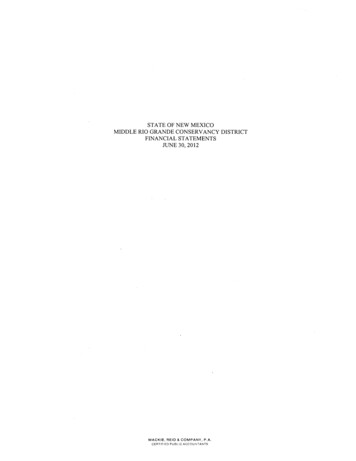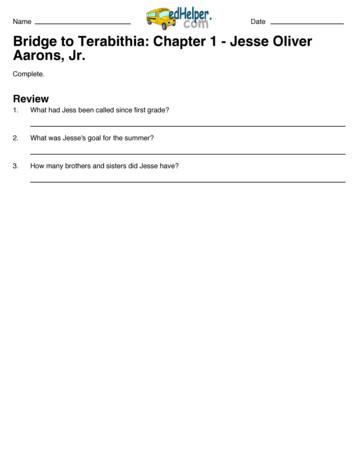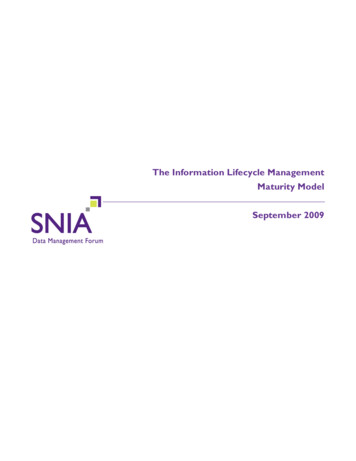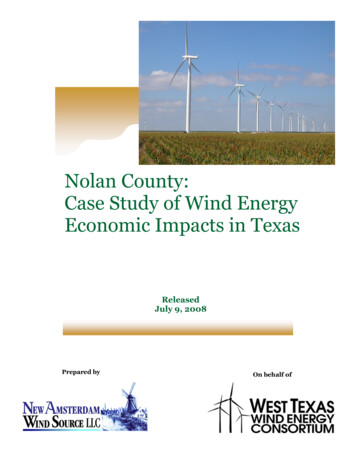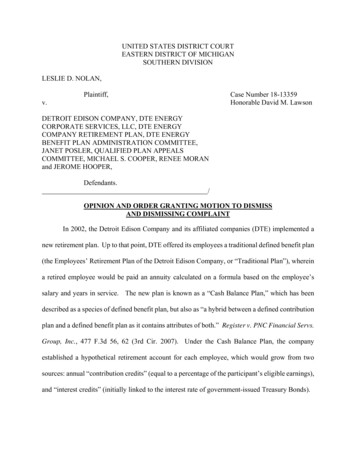
Transcription
UNITED STATES DISTRICT COURTEASTERN DISTRICT OF MICHIGANSOUTHERN DIVISIONLESLIE D. NOLAN,Plaintiff,Case Number 18-13359Honorable David M. Lawsonv.DETROIT EDISON COMPANY, DTE ENERGYCORPORATE SERVICES, LLC, DTE ENERGYCOMPANY RETIREMENT PLAN, DTE ENERGYBENEFIT PLAN ADMINISTRATION COMMITTEE,JANET POSLER, QUALIFIED PLAN APPEALSCOMMITTEE, MICHAEL S. COOPER, RENEE MORANand JEROME HOOPER,Defendants./OPINION AND ORDER GRANTING MOTION TO DISMISSAND DISMISSING COMPLAINTIn 2002, the Detroit Edison Company and its affiliated companies (DTE) implemented anew retirement plan. Up to that point, DTE offered its employees a traditional defined benefit plan(the Employees’ Retirement Plan of the Detroit Edison Company, or “Traditional Plan”), whereina retired employee would be paid an annuity calculated on a formula based on the employee’ssalary and years in service. The new plan is known as a “Cash Balance Plan,” which has beendescribed as a species of defined benefit plan, but also as “a hybrid between a defined contributionplan and a defined benefit plan as it contains attributes of both.” Register v. PNC Financial Servs.Group, Inc., 477 F.3d 56, 62 (3rd Cir. 2007). Under the Cash Balance Plan, the companyestablished a hypothetical retirement account for each employee, which would grow from twosources: annual “contribution credits” (equal to a percentage of the participant’s eligible earnings),and “interest credits” (initially linked to the interest rate of government-issued Treasury Bonds).
When DTE made the change, it did not require existing employees who had earned benefitsunder the old plan to switch to the new plan. Instead, it provided a window for those employeesto elect to stay with the Traditional Plan or opt in to the new one, thereby allowing them to receivefuture retirement benefits under one plan or the other, but not both. That choice carried somemeasure of risk, because no certain prediction could be made that at retirement time an individualemployee would do better under the new plan than the old one.There was a further catch. Existing employees who elected to switch to the new CashBalance Plan would have their accrued retirement benefits frozen and then receive a hypotheticalretirement account balance based on what they had accrued already under the Traditional Plan,projected forward to their retirement date, and then reduced to present value. That establishedtheir opening cash balance, against which future accruals would be measured. In one way, thatbenefited them. It provided a guarantee that no matter how slowly their cash balance account grewcompared to the opening balance, they would be guaranteed the monthly benefit upon retirementthey had earned as of the date the account was frozen, and no less. Indeed, ERISA requires asmuch. See 29 U.S.C. § 1054(g). But their cash balance account would not grow beyond that initialbalance until their accumulated credits caught up to that initial balance, “a phenomenon known inpension jargon as ‘wear away.’” Cigna Corp. v. Amara, 563 U.S. 421, 431 (2011).Plaintiff Leslie Nolan elected to switch to the Cash Balance Plan in the spring of 2002,after she had worked at DTE for just over 23 years. When she went to retire in 2017 after 38 yearswith the company, she was unpleasantly surprised to learn that her pension benefit had not grownmuch since her account was frozen in 2002. She believed that she should receive a monthly benefitas calculated under the Traditional Plan plus the amount accrued under the Cash Balance Plansince 2002, irrespective of the wear away. She sued the defendants under various sections of the-2-
Employee Retirement Income Security Act (ERISA), 29 U.S.C. § 1001, et seq., alleging that theybreached the terms of the retirement plan, they failed to explain the election in terms that could beunderstood by the average person, and they failed to give notice that the new plan could result ina reduction of accrued benefits. The defendants responded to the complaint with a motion todismiss under Federal Rule of Civil Procedure 12(b)(6).The Court heard oral argument on May 8, 2019. The materials furnished by the defendantsto their employees in 2002 plainly state that a retiree electing to switch to the Cash Balance Planwould receive the “greater of” the accrued benefit under the traditional plan or under the CashBalance Plan, but not both. The defendants did not breach the plan when calculating the plaintiff’smonthly pension payment upon her retirement. And the plan materials provided notice thatbenefits under the new plan could be less, using language that could be understood by the averageperson. Moreover, all of the plaintiff’s claims are time-barred. Because the plaintiff has not stateda claim for which relief can be granted, the Court will grant the defendants’ motion and dismissthe complaint.I.The following facts are taken from the complaint, the attached documents to it, and thematerials referenced in the complaint.Leslie Nolan began working for DTE on December 17, 1979. She remained at DTE for 38years — most recently in the role of financial analyst — until her retirement on December 17,2017. During her employment, Nolan participated in the two pension plans mentioned above,which are sponsored and administered by DTE and the DTE Energy Benefit Plan AdministrationCommittee.-3-
Nolan initially participated in the Traditional Plan, which became effective April 1, 1943.That was a defined benefit pension plan that computed an employee’s retirement benefit as apercentage of average salary multiplied by years of service. The benefits under the TraditionalPlan were paid as an annuity on a monthly basis.Between March 4, 2002 and April 26, 2002, DTE invited eligible employees whoparticipated in the Traditional Plan to transfer to its new retirement program, the Cash BalancePlan. The plaintiff alleges that with its invitation, DTE promised employees that if they elected totransfer to the new plan, they would receive both the “frozen and protected” pension benefit theypreviously earned under the Traditional Plan plus the benefit they would earn thereafter under theCash Balance Plan (“A B Promise”). Transferring to the Cash Balance Plan was voluntary andrequired affirmative action; otherwise an employee remained in the Traditional Plan.Nolan elected to transfer to the Cash Balance Plan. In 2017, because of her age and lengthof service, she was eligible to retire before she reached age 65 without any reductions in benefits.But she learned then that her cash balance account had not grown — mostly due to her reducedsalary when she went to part-time status and sharply declining interest rates — and she had not“caught up” to her frozen account balance under the Traditional Plan. Plainly she would have beenbetter off had she stuck with the Traditional Plan.Nolan contends that she is entitled to a pension based on the A B formula, and if not, shewas misled when the elections were presented to her in 2002. DTE says that the new plan containsno such formula, and employees were fully informed about the options, including the uncertaintyof future outcomes, and that the employees were counseled through at least four resources inmaking their decisions: the Retirement Choice Decision Guide (“Decision Guide”), a personalizedstatement of their accrued benefits and the projected conversion to an opening cash balance, an-4-
online modeling tool, and in-person workshops and webcasts presented by an outside financialcounselor. According to the plaintiff, DTE expressed the A B Promise in both section 6.01 of theRetirement Plan and the Decision Guide that also was furnished to eligible employees.DTE’s Retirement PlansArticle V of the revised Retirement Plan described the Cash Balance Plan, which if anemployee elected became effective on June 1, 2002. A “Cash Balance Account” would bemaintained for each employee who elected to participate in the Cash Balance Plan. The Accountwas described as “a hypothetical account used for bookkeeping purposes only to determine theamount of a Participant’s retirement benefits that are payable pursuant to Article VI.” Art. V, §5.01, ECF No. 1-2, PageID.94. For those participants who transferred from the Traditional Plan,the hypothetical account would reflect an “Opening Cash Balance” equal to the actuarialequivalent of the participant’s “accrued benefit” under the Traditional Plan as of the date oftransfer. Id., § 5.02(d), PageID.95. The accrued benefit would be converted into a lump sum usingthe applicable mortality table and interest rates. Ibid. Thereafter, annual “contribution credits”equal to a percentage of the participant’s eligible earnings as well as “interest credits” then wouldaccrue on the hypothetical account. Id., § 5.02(e), (f), PageID.95.The Retirement Plan defined “accrued benefit” as “the benefit that a Participant has earnedunder the Plan on any given date, without regard to the Participant’s nonforfeitable right to suchbenefit, and computed in accordance with the applicable Accrued Benefit formulas in Article VI.”Art. 2, § 2.01, ECF No. 1-2, PageID.65.Section 6.01 sets forth the formula by which a participant’s accrued benefit would bedetermined:(1)DTE and MCN Traditional Plan Participants. At any point in time, a DTEor MCN Traditional Plan Participant’s Accrued Benefit, payable in the Normal-5-
Form commencing on the Participant’s Normal Retirement Date, shall becalculated in accordance with Sections 6.02 through 6.05, as applicable.(2)DTE and MCN Cash Balance Plan. At any point in time, a DTE or MCNCash Balance Plan Participant’s Accrued Benefit, payable in the Normal Formcommencing on the Participant’s Normal Retirement Date, shall be the ActuarialEquivalent of the Participant’s Cash Balance Account, as described in Article V.Id., PageID.99. Section 6.02 states that “[a] Participant shall have a fully vested right to a NormalRetirement Benefit upon attainment of Normal Retirement Age, which shall be age 65.” Ibid.Section 6.03 defines the amount of a Cash Balance Plan participant’s Normal Retirement Benefitas “equal to the Participant’s Accrued Benefit computed as of the Participant’s Normal RetirementDate.” Ibid. Section 6.04 defines the amount of a DTE Traditional Plan participant’s NormalRetirement Benefit as a percentage of the participant’s average final compensation multiplied byyears of service with a minimum benefit of a fixed amount multiplied by years of service. Id.,PageID.100. Section 6.05 pertains to benefits accrued under the traditional plan of MCN EnergyGroup, one of DTE’s merger partners, which does not impact the issues in this case.Decision GuideDTE employees considering switching to the Cash Balance Plan were provided a 46-pageDecision Guide summarizing a three-step process for choosing a plan:1. Educate – Learn about your options and how they work.2. Evaluate – After educating yourself about your options, evaluate them accordingto your individual situation. With the modeling tool available through theRetirement Choice Web Site, evaluate and compare the retirement options usingdata from your Personalized Statement and by entering your own assumptions.3. Elect – Once you have finished reading this Decision Guide and exploring theother resources available to you, you will need to visit the Retirement Choice WebSite to elect the option that is best for you.Decision Guide at 1, ECF No. 1-3, PageID.224. Although the Decision Guide was promoted asemployees’ “primary source of printed Retirement Choice information,” DTE also provided access-6-
to the other resources mentioned above, including a “Retirement Choice Personalized Statement”that provided an overview of how an employee’s pension benefit was calculated at the time andhow it would convert under the Cash Balance Plan, as well as “Retirement Choice Workshops”presented by an independent consulting firm. Id., PageID.227-28.The first page of the “Educate” section of the Decision Guide provided a summary of whatwould happen to retirement benefits if an employee elected to continue with the Traditional Planversus switching to the New Horizon Plan (Cash Balance Plan). Id., PageID.230. Under theformer, there would be no change to the formula of the pension plan as the employee wouldcontinue to receive a pension benefit based on average annual eligible earnings and years of benefitservice. Ibid. Under the latter, the Decision Guide expressly noted, As of December 31, 2001, you will stop earning benefits under the DetroitEdison Traditional Pension Plan and begin earning benefits under the NewHorizon Pension Plan. Your accrued benefit from the Traditional Plan will be converted using apresent value conversion factor into an initial cash balance benefit for January1, 2002 based on the lump-sum value of your accrued benefit under theTraditional Pension Plan on December 31, 2001. Your election will be used only if you continue to meet the eligibilityrequirements listed on page 3 until at least June 1, 2002, when your electionbecomes effective. Benefits as of January 1, 2002 will be based on yourelection. Once you are vested, you are eligible for the greater of any Traditional PensionPlan retirement benefits you have accrued as of December 31, 2001 or May 31,2002, the dates on which your Traditional Pension Plan benefit is frozen andprotected.Ibid.The following page presented the formulas for calculating retirement benefits under theTraditional Plan and the Cash Balance Plan. The Decision Guide explained that under theTraditional Plan, the retirement benefit was based on average salary and years of service, and that-7-
the employee “do[es] not contribute to this plan. The Company fully pays for your benefits underthe plan.” It went on to state,Your cash balance pension benefit increases each year with two types of credits: Contribution credits – Equal to 7% of your eligible earnings each year. Interest Credits – Based on average 30-year Treasury rates* for the month ofSeptember prior to the plan year.*Interest Credit Update: The U.S. Department of the Treasury has announced thatit will stop issuing 30-year Treasury bonds in 2002, but it may continue to publisha 30-year Treasury rate. This rate is used under ERISA for pension funding andbenefit calculations. If the Treasury stops publishing the 30-year Treasury rate,Congress will have to amend ERISA to replace the 30-year Treasury rate with acomparable measure. The pension plan will automatically change with the law. Ifthis occurs, the change under ERISA will affect both the cash balance interestcredits and the value of your Traditional Pension Plan benefit.Id., PageID.231.The next page stated that if an employee chose the Cash Balance Plan, her “age 65 accruedbenefit under [the] Traditional Pension Plan as of December 31, 2001 would be converted to aninitial cash balance benefit in the [Cash Balance Plan] on January 1, 2002.” Id., PageID.232. TheDecision Guide explained that because an employee’s pension benefit under the two plans isexpressed differently — a monthly amount under the Traditional Plan and a one lump-sum amountat present value under the Cash Balance Plan — the “current monthly annuity benefit under theTraditional Pension Plan will need to be converted to a total lump-sum amount in today’s dollarsby multiplying it by a present value conversion factor based on [the employee’s] age as of January1, 2002.” Ibid. It went on to say that the “initial cash balance benefit in the [Cash Balance Plan]is determined by multiplying [the employee’s] monthly age 65 current Traditional Plan benefitaccrued through December 31, 2001 by [the] present value conversion factor.” Ibid. It also notedthat the “interest rate used for the initial cash balance benefit is 5.48%, which is the average 30--8-
year Treasury rate for September 2001,” and that the table of all the present value conversionfactors used to determine lump-sum payments under qualified pension plans was included in thepackage provided to eligible employees. Ibid.The pages that followed included additional information about the two plans, including aside-by-side comparison. Id., PageID.233. In describing how an employee’s benefit grows underthe Cash Balance Plan, the Decision Guide repeated that the cash balance benefit increases eachyear with contribution credits and interest credits. Ibid. In the adjacent column it repeated theformula for computing one’s benefits under the Traditional Plan, explaining that the monthlyaccrued benefit equals a percentage of annual eligible earnings multiplied by years of service. Ibid.The Decision Guide also encouraged employees to “Evaluate” their options, including byviewing “online retirement benefits projections through examples” and learning “how usingdifferent assumptions and scenarios with the modeling tool on the Retirement Choice Web Sitewill impact how [their] benefits are projected” under the two plans. Id., PageID.242. The DecisionGuide provided four hypothetical examples to assist in understanding how the plans compare forsample employees. Based on the limited information about the plaintiff stated in the complaint, itappears that sample employee “Terry” most closely resembles the plaintiff.The hypotheticals used various personal data inputs, including age, average monthlyeligible earnings, years of service, accrued monthly pension, and initial cash benefit, as well asseveral assumptions, including long-term average annual compensation growth, future cashbalance interest credits, and retirement age. Ibid. The projected value of benefits at retirementage for each example were reflected on two charts, varying the assumption for future cash balanceinterest credits from 6% in the first chart to 8% in the second chart. Id., PageID.244. Dependingon the personal data inputs and assumptions used for each sample employee, the projected value-9-
of benefits could be higher or lower under the Cash Balance Plan than under the Traditional Planas the employee approached retirement age. See id., PageID.244-247. For “Terry,” there was noadvantage to switching to the Cash Balance Plan under the 8% assumption, and there was a distinctdisadvantage under the 6% assumption.The Decision Guide instructed employees to use the online modeling tool to input theirown data and assumptions to model scenarios and project potential benefits. Id., PageID.248. Italso noted that an employee’s actual benefits would depend on changes in pay, years of service,changes in the interest rates for the pension plan, and investment returns. Id., PageID.253. On apage titled, “How Do the Assumptions I Enter Impact My Benefit Projections?” the DecisionGuide explained that increasing the “future cash balance interest credits” assumption will result in“a higher estimated benefit under the [Cash Balance Plan].” Id., PageID.251. “Decreasing thisassumption will decrease your projected benefits under this plan.” Ibid.On another page titled, “What Should I Keep in Mind as I Review All of My ModelerResults?”, the Decision Guide stated, among other things:The pension benefit you earned at conversion under the Traditional Pension Plan isprotected under the [Cash Balance Plan]. Although the [Cash Balance Plan] growsat a steady rate, do you find the [Cash Balance Benefit] does not catch up to thefrozen accrued benefit under your Traditional Pension Plan for a number of years?If this happens and you are planning to leave DTE Energy during this time, yourpension benefit may not grow.Do you notice more than one crossover point? Which benefit is better if you expectto leave DTE Energy at an age before or after each of the crossover points?Id., PageID.254. The following page cautioned,If you are close to early retirement age . . . You may notice that while the cashbalance benefit in the [Cash Balance Plan] is growing at a steady rate, it may takea number of years before the cash balance benefit becomes greater than the valueof your December 31, 2001 or May 31, 2002 accrued benefit under the TraditionalPension Plan. This may happen as you become eligible for early retirement benefits-10-
under the Traditional Pension Plan, because the value of your early retirementfactors were not included in your initial cash balance benefit.If you choose the [Cash Balance Plan], effective on June 1, 2002, your TraditionalPension Plan benefit on May 31, 2002 is frozen and protected. Therefore, the valueof your [Cash Balance Plan] benefit will never be less than the greater of the benefityou had on December 31, 2002 or May 31, 2002 under the Traditional PensionPlan.Id., PageID.255.The Decision Guide concluded with information on how to elect a pension plan, deadlinesto remember, and a glossary of key terms mentioned throughout the Decision Guide. Among theterms defined was “30-Year Treasury Rates,” which referenced a chart in the adjacent columndisplaying average Treasury rates for the month of September for each of the last 10 years andindicating that “the Treasury rate has fluctuated over the years – a point you may want to considerwhen modeling your assumptions.” Id., PageID.260. Although the chart showed that the average30-year Treasury rate in 1991 was 7.95%, that rate steadily had declined over the years. Mostlyrecently, it had dropped from 6.07% in 1999 to 5.48% in 2001. Ibid.The last page of content, preceded by three blank pages on which to take notes, notifiedthat the Decision Guide is a “Summary of Material Modifications” of DTE’s retirement benefitsprograms, that DTE reserves the right to change its retirement plans at its discretion, and that legaldocuments supersede any information presented within the Decision Guide. Id., PageID.268. Italso included text box stating the following:NOTICE OF POTENTIAL ADVERSE IMPACT ON FUTURE BENEFITACCRUALSWhen making your decision between the Traditional Plans and the [Cash BalancePlans], you need to keep in mind that the cash balance pension formula in the [CashBalance Plan] impacts individuals differently depending on a combination ofservice, age and other circumstances. It is important that you use the modeler thatis provided to determine if your future pension accruals could be reduced orotherwise adversely impacted under the [Cash Balance Plan] formula. If you elect-11-
the [Cash Balance Plan], the greater of your December 31, 2001 or your May 31,2002 accrued benefit under the Traditional Pension Plan will be frozen, and youwill never receive a [Cash Balance Plan] benefit that is less than the actuarialequivalent of your protected Traditional Pension Plan benefit on December 31,2001 or May 31, 2002. However, due to the application of the cash balance formulain the [Cash Balance Plan], it is possible that your benefit will not grow initially ormay grow at a slower rate than under the Traditional Pension Plan.Id., PageID.268.Financial Planning SeminarIn addition to the Retirement Plan and Decision Guide, DTE made available a financialplanning seminar presented by The Ayco Company, L.P. (“Ayco”), the independent consultingfirm that DTE had hired. Although it is not clear from the complaint whether Nolan attended theseminar in person, she possessed a copy of the Power Point presentation that was used during theseminar. Ayco Power Point, ECF No. 3-10. The presentation repeated and summarized theinformation provided in the Decision Guide, including the four hypothetical examples for sampleemployees with varying assumptions. Id., PageID.348.Before addressing the hypotheticals, the presentation highlighted the “Impact of FutureInterest Rates on Your Modeling Results,” explaining that a selected interest rate impacts the“Cash Balance Plan annual interest credit and guaranteed monthly income from annuity option”and “the [p]resent value of Traditional Pension Plan monthly benefit included in total valuecomparison.” Id., PageID.352. As illustrated in the Decision Guide, depending on the interestrate and assumptions used, a sample employee’s projected benefit growth under the Cash BalancePlan at times was outpaced by the projected growth under the Traditional Plan. Id., PageID.353.The presentation also included a graph of interest rate history dating back to 1991, illustrating boththe 30-year Treasury Bond rate and Consumer Price Index (CPI). Id., PageID.357.-12-
Nolan’s Retirement BenefitsNolan elected to transfer to the Cash Balance Plan during the offer period. At the time, shewas 43 years-old and had 22.5 years of service with DTE. In the years following her election, the30-year Treasury Bond rates and other applicable rates under the Retirement Plan steadilydecreased.In September 2017, at age 59 and shortly before her planned retirement date, Nolanreceived a four-page “Pension Calculation Statement” (PCS) from DTE that included her paymentoptions and the pension she would receive under each option if she retired on December 2, 2017.The PCS listed several figures, including Nolan’s minimum accrued benefit earned as of December31, 2001 and May 31, 2002. According to the statement, Nolan’s minimum accrued benefit onMay 31, 2002 (the greater of the two) was 1,581.19.Because the PCS included numerous undefined terms that Nolan did not understand andlacked an explanation as to how her pension benefit amounts were calculated, on October 14, 2017,Nolan sent a letter to the Plan Administrator seeking (i) clarification of the undefined terms in thePCS and the methodology used to determine her pension amounts, (ii) copies of the RetirementPlan (both before and after she transitioned to the Cash Balance Plan), and (iii) copies of theRetirement Plan’s summary plan descriptions (SPD).On November 6, 2011, Nolan received a letter from Emily Sharp, DTE’s Supervisor ofRetirement Income Benefits, in response to Nolan’s document and information request. The letterresponded to each of Nolan’s requests, answering that a copy of the applicable document had beenprovided with the letter or why no responsive document existed and explaining how the amountslisted on the PCS were computed. Although the complaint alleges that Sharp did not provide anySPD in effect when DTE rolled out the Cash Balance Plan and instead furnished the most current-13-
version from 2016, Sharp’s letter noted that ERISA “only requires providing the most currentSummary Plan Description.” Letter, ECF No. 3-4, PageID.298. Central to the parties’ dispute andin response to Nolan’s inquiry regarding what the “Minimum 05/31/2002 Benefit” meant and howit was computed, Sharp wrote,In 2002, you were given the option to (1) continue accruing benefits under the DTETraditional Plan, or (2) have your accrued benefit converted to an opening balancein the [Cash Balance Plan], and thereafter earn benefits in the [Cash Balance Plan].You elected to move into the [Cash Balance Plan].The IRS does not allow pension participants to be paid a lower benefit than hasbeen accrued at any point in your career. As a result, your DTE Traditional benefitwas preserved as a minimum when you moved to the [Cash Balance Plan] and thatminimum benefit is called the “Minimum 5/31/2002 Benefit.” Your minimum5/31/2002 Benefit was calculated based on the DTE Traditional Plan formulareflecting your earnings and years of service up to 5/31/2002. In your case, thisMinimum 5/31/2002 monthly benefit is larger than the equivalent monthly benefityou have earned in the Cash Balance Plan because you were a full-time employeethrough November 27, 2001 and reduced to part-time status after that date. YourMinimum 5/31/2002 Benefit was primarily based on your annual compensation asa full-time employee, while the annual Contribution Credits to your Cash Balanceaccount were based on your lower annual compensation as a part-time employee.Because your Minimum 5/31/2002 Benefit is the larger benefit, your monthly Planbenefit payable at your December 2, 2017 commencement date is your Minimum5/31/2002 Benefit.Ibid. Sharp further explained that Nolan’s equivalent monthly benefit earned in the Cash BalancePlan was 987.83, calculated by dividing her cash balance account amount of 190,874.93 by the“Lump Sum Factor” of 193.2273, which was based on IRS specified rules for assumed future lifeexpectancy and interest rates. Id., PageID.299. Based on these representations, the complaintalleges that “DTE concluded that Nolan was entitled to no new pension benefits for the 15½ yearsshe participated in the Cash Balance Plan.” Compl. ¶ 48.The Administrative ProceedingsOn January 9, 2018, Nolan submitted a claim for additional pension benefits to DTE’s“Pension Plan Claims” department, asserting that the method and manner of calculating her-14-
pension entitlement was incorrect for “several reasons.” Nolan principally objected to DTE’sfailure to mention and use of the “larger of” methodology in computing her pension benefitamount. Nolan wrote that Section 6.01 of the Retirement Plan contemplated a “two-part formula”for calculating a participant’s “Accrued Benefit,” summarizing the methodology for computingbenefits for participants under the Traditional Plan and the Cash Balance Plan. Based on Nolan’sunderstanding of that formula, she asserted that “if a DTE employee participated in both plans,their total Accrued Benefit would equal the pension they earned under the traditional plan PLUSthe pension they earned under the cash balance plan.”Nolan further asserted that the “larger of” methodology conflicted with representationsDTE made to her and other DTE employees who were invited to transfer to the Cash Balance Plan,as they never were told that they would receive the “larger of,” “greater of,” or “only one of” thebenefits they earned under the Traditional Plan and Cash Balance Plan. Nor were they told that ifthey elected to transfer that they “might earn no new benefits for a significant period of time, orpossibly never.” Citing the Decision Guide at Page 7, Nolan wrote that she and other employees“were told that [they] would re
(2) DTE and MCN Cash Balance Plan. At any point in time, a DTE or MCN Cash Balance Plan Participant's Accrued Benefit, payable in the Normal Form commencing on the Participant's Normal Retirement Date, shall be the Actuarial Equivalent of the Participant's Cash Balance Account, as described in Article V. Id., PageID.99. Section 6.02 .


